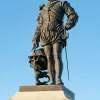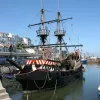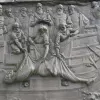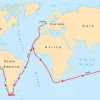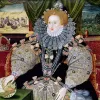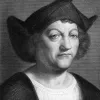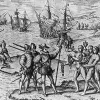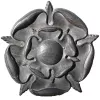Sir Francis Drake
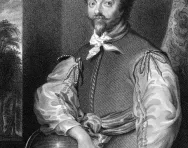
Who was Sir Francis Drake?
The most famous seaman of the Elizabethan age, Sir Francis Drake became the first Englishman to circumnavigate the globe. He was one of the great early European navigators.
Drake was vice admiral of the English fleet at the time of the defeat of the Spanish Armada.
Top 10 facts
- Drake was born in Tavistock, Devonshire. His family was very religious and his father was a Protestant preacher. Although the family were respectable they were not very wealthy and Drake was sent to sea at the age of twelve.
- Drake was apprenticed to a merchant and his seafaring skills brought him to the attention of his cousins, the Hawkins family, who were privateers. He participated in illegal slave trading expeditions with his cousin Sir John Hawkins.
- Privateers were allowed by the government to commit acts of piracy against Spanish property; in return their sponsors received a share of the plunder. In 1572 Drake received his own privateer's commission from Elizabeth I.
- In 1568 Drake and Hawkins were trapped by the Spanish at the port of San Juan de Ulua in Mexico. Many of their men were killed and Drake had to swim to safety. This incident resulted in him developing a life-long dislike of Spain.
- Between 1577 and 1580 he successfully sailed around the globe becoming the first Englishman to do so. The first circumnavigation was made by Ferdinand Magellan some fifty years earlier.
- The ship which Drake used to circumnavigate the world, the Golden Hind, was originally called the Pelican.
- One of Drake’s most famous exploits was the ‘Singeing of King of Spain’s beard’. This refers to his attack on Cadiz in 1587. Drake and his fleet managed to destroy 20-30 enemy ships and their supplies, delaying the launch of the Armada.
- Drake was allegedly playing bowls on Plymouth Hoe when news reached him of the imminent arrival of the Spanish Fleet. He is said to have remarked that he had time to finish the game before defeating the Spanish.
- Drake was a vice admiral of the English fleet at the time of the Armada. He is credited with the idea of using fire ships to scatter the Spanish Fleet, making the individual ships more vulnerable to English gunfire.
- Drake’s final expeditions against the Spanish were unsuccessfully. In 1589 he lost 20 ships and 12,000 men trying to help the Portuguese who were rebelling against Spanish occupation. He died of dysentery after engaging with the Spanish in the Caribbean.
Timeline
- c1540Drake born in Tavistock, Devon

- c1563Drake makes his first voyage to Americas with Sir John Hawkins
- 1566Drake obtains his first command, the Judith
- 1568Drake’s fleet attacked by Spanish
- 1570-71Drake voyages to West Indies
- 1573Drake captures Spanish treasure at Nombre de Dios
- 1577-1580Drake circumnavigates the globe in the Golden Hind
- 1578Drake executes his co-commander Thomas Doughty for mutiny
- 1580Drake purchases Buckland Abbey
- 1581Drake is knighted by Queen Elizabeth I. He becomes Mayor of Plymouth and a Member of Parliament

- 1585-1586Drake raids Spanish colonies
- 1586-1588Preparation of Spanish Armada
- 1587Drake ‘singes the King of Spain’s beard’ by attacking the Spanish fleet at Cadiz
- 1588Spanish fleet sails from A Coruna
Vice Admiral Drake is second in command of the English fleet against the Armada
- 1589Drake continues attacks on Spain
- 1595Drake wages unsuccessful campaigns in Spanish America
- 1596Death of Sir Francis Drake


Boost Your Child's Learning Today!
- Start your child on a tailored learning programme
- Get weekly English & maths resources sent direct to your inbox
- Keep your child's learning on track
Did you know?
- Francis Drake was the first of twelve sons of Edmund Drake and Mary Mylwaye.
- Drake’s conduct as a young apprentice to a ship master was so impressive that the master later gave him his ship!
- When he landed in what is now California in the United States, Drake named it Nova Albion (new England)!
- tQueen Elizabeth I knighted Drake when she dined on board his ship, the Golden Hind, at Deptford on the River Thames.
- King Philip II offered a reward of 20,000 ducats for Drake’s life.
- Drake died of dysentery and was buried at sea. He was dressed in full armour and placed in a lead coffin.
- Drake married twice but did not have any children.
Look through the gallery below and see if you can spot the following:
- A statue of Sir Francis Drake in Portsmouth
- The Golden Hind replica
- Drake being knighted by Queen Elizabeth
- Drake’s burial at sea
- Drake playing bowls at Plymouth Hoe
- A map showing the route taken by Drake as he circumnavigated the world
Gallery
About
Drake was one of the most successful privateers of all time. His exploits were legendary and his attacks on Spanish property and interests made him a very rich man.
Drake demonstrated his abilities as a sailor from an early age. His explorations helped to increase knowledge about the world. He was the first Englishman to navigate the Straits of Magellan, a sea route at the southern tip of South America, and sailed further north along the coast of the Americas than any other European had before, landing in what is now California in the United States.
His daring raid on Cadiz and his tactical wizardry against the Armada demonstrated skilful seamanship and courage; he was a hero at home in England though he took part in the slave trade and was by all acoounts a very ruthless man.
The Spanish viewed Drake as a pirate who plundered and robbed their property, a ruthless destroyer of ships and killer of men. They nicknamed him ‘the Dragon’. Drake’s activities, supported by Elizabeth I, were a severe provocation to Philip of Spain and he sought his revenge with the launching of the Spanish Armada.
Famous friends
Sir John Hawkins (1532-1595), a second cousin of Drake. He rose from being a privateer to treasurer and controller of the English navy. His innovations in ship design helped the English fleet to defeat the Armada. He was a vice admiral at the time of the Armada and was knighted by Elizabeth I. He died on the same final expedition as Drake.
Sir Walter Raleigh (1554-1618) an Elizabethan aristocrat, poet, explorer and adventurer. A great favourite of Elizabeth I, he was keen to promote English settlement in North America and is credited with introducing the potato and tobacco into England. Imprisoned on a number of occasions, he was finally executed by James I.
Related Videos
Just for fun...
- Explore a portrait of Drake from the National Maritime Museum
- Take a CBBC quiz and see how much you know about Sir Francis Drake
Find out more
- Information about the swashbucking life of Sir Francis Drake, seafarer and pirate!
- Look at a map of Tudor exploration routes, including Drake's
- Find out about the lives of Tudor explorers including Sir Francis Drake
- See pictures of important moments in Drake's life
- Sir Francis Drake's Atlas of the World is now in Portsmouth
Best children's books about Sir Francis Drake
See for yourself
- Visit Buckland Abbey, Drake’s home
- You can see the Drake Jewel, a gift from Elizabeth I at the Victoria and Albert Museum London
- Step aboard a replica of The Golden Hind in Brixham, Devon
- Another replica of Drake's galleon is moored in London: the Golden Hinde II
- At the Pigott Family Gallery in the National Maritime Museum in Greenwich you can find out more about Tudor and Stuart seafarers
Also see

Give your child a headstart
- FREE articles & expert information
- FREE resources & activities
- FREE homework help
